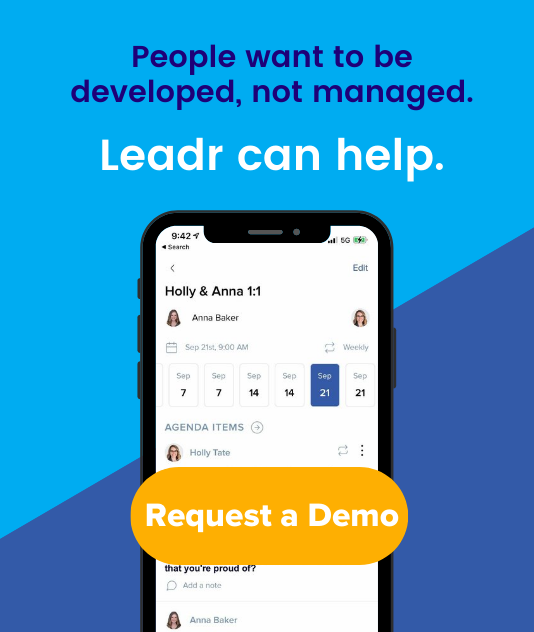Middle Manager Success is Vital to Boosting Your Bottom Line. Here’s why.
It’s a well-known fact that middle managers are one of the most valuable and yet least equipped levels within your organization. Only 20% of managers strongly agree that their organizations help them to be successful people managers. Executives have been scratching their heads for years trying to determine how to solve this massive leadership gap. It turns out the solution is fairly simple.
McKinsey recently broke it down for us. Here’s an overview of what their latest data is saying about how to equip our middle managers to have a better employee experience, which directly impacts employee performance and your bottom line.
First, it’s important to set the stage for just how vital this issue is.
“Organizations whose managers exhibit strong leadership behaviors realize better bottom line performance.” The data is clear: Companies in the top quartile for manager skillsets saw a 43% increase in shareholder returns over 5 years versus 2% for the bottom quartile.
Now that we understand the severity of the issue, let’s learn how to solve it.
1. Implement consistent leadership practices
Companies with higher manager cohesion (where managers behave consistently across the organization) have almost 2x the organizational health score of those with low manager cohesion.
In other words, it’s vital to create systems and processes that all managers can operate within. Consistency ensures each team member experiences clear expectations to know whether or not their winning in their role, a higher likelihood of equal treatment, and increased psychological safety.
We can’t expect new managers to step into their roles knowing what it takes to be successful. Giving them a framework helps them know where to focus their efforts.
That’s why we created Leadr Academy. Our world-class manager training gives leaders the framework they need to build healthy teams and drive performance—all with the support of expert coaches. Want to enroll your managers? Let us know here and we'll send you more details.
2. Ensure the manager-to-employee ratio is optimized
There’s a saying: if you can’t share a pizza with your direct reports, you have too many people on your team.
You should be able to have effective 1:1 meetings with every person on your team at least every other week (if not every week). 1:1s bring clarity, help anticipate issues and roadblocks, build rapport, and accelerate progress. More on that here.
We know the manager-to-employee relationship is the foundation of the employee experience which is a leading indicator of engagement and retention. And the 1:1 meeting is a leader’s most important tool to facilitate that relationship.
Make sure your managers are encouraged to have their 1:1 meetings and are equipped to perform them well.
3. Switch from managing people to developing them
Managers don’t enjoy micromanaging any more than their employees do. Micromanagement is a side effect of lacking communication and alignment.
Luckily there are tools that help track employee activity in a healthy way so employees are held accountable and managers are freed up to coach and develop their team instead of tracking their every move.
We know that teams who are engaged exhibit behaviors like contributing to their 1:1 meetings, setting goals and action items, offering employee recognition, requesting and offering feedback, and participating in growth and development opportunities.
Leadr is a platform that helps managers become better leaders by keeping all of the activities listed above in one place. When a manager is provided with insights on which employees are actively engaged, they’re better able to coach and develop people in the right areas.
4. Provide continuous development opportunities for managers
The 2020 Work Institute report says, "The number one reason people left their jobs voluntarily is because of “career development.' The least important reason? 'Compensation and benefits.'”
The fix? Make a custom development plan for each manager based on their personal goals. Choose one theme each manager wants to work on and collaborate to build a 6-month plan for how they’ll get there including workshops, books, podcasts, stretch projects, shadowing opportunities, etc.
When they knock that out, start again.
Development isn't just about monetary benefits or promotions. Here are a few ways you can pour into your people that don't look like a pay increase.
5. Engage in a continuous feedback loop
Creating a culture of feedback means that every person on the team has a voice. Every team member should be consistently asking other employees above and below them on the org chart how they are measuring up.
This can be done monthly or quarterly by prompting a few team members you work with 3 simple questions:
- What are my top 3 skills?
- What are my bottom 3 skills?
- Any additional feedback?
This has copious benefits for your organization.
- When leaders ask for feedback, it shows the team they’re open to growth.
- We learn more from watching than hearing. Lead by example.
- Employees are developing each other which frees you up to focus on strategy.
- The ability to share feedback openly builds trust.
- 92% of employees believe negative feedback is an effective way to improve performance when delivered with kindness and clarity. (Harvard Business Review)
The data is out and it’s clear: if you want to win as an organization, make sure you’re equipping your managers to be the force multipliers they ought to be (and want to be). The research shows that middle managers are the most burned-out job level across the organization.
By building on these 5 small, intentional habits, you can boost middle manager morale and contribute back to your bottom line.
What are you waiting for? Which of these 5 tips can you implement today?
Leadr is a people development company that combines world-class manager training with a powerful platform to accelerate team performance. Check out a quick product overview to learn more about our software or let us know if you want to talk about manager training.
Share this
You May Also Like
These Related Stories

Your Team’s Not Just There to Work. They’re There to Grow.

Three Simple Strategies to Raising Up New Leaders On Your Team







No Comments Yet
Let us know what you think